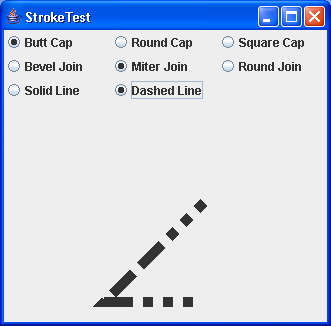This program demonstrates different stroke types.

/*
This program is a part of the companion code for Core Java 8th ed.
(http://horstmann.com/corejava)
This program is free software: you can redistribute it and/or modify
it under the terms of the GNU General Public License as published by
the Free Software Foundation, either version 3 of the License, or
(at your option) any later version.
This program is distributed in the hope that it will be useful,
but WITHOUT ANY WARRANTY; without even the implied warranty of
MERCHANTABILITY or FITNESS FOR A PARTICULAR PURPOSE. See the
GNU General Public License for more details.
You should have received a copy of the GNU General Public License
along with this program. If not, see <http://www.gnu.org/licenses/>.
*/
import java.awt.BasicStroke;
import java.awt.BorderLayout;
import java.awt.EventQueue;
import java.awt.Graphics;
import java.awt.Graphics2D;
import java.awt.GridLayout;
import java.awt.Point;
import java.awt.event.ActionEvent;
import java.awt.event.ActionListener;
import java.awt.event.MouseAdapter;
import java.awt.event.MouseEvent;
import java.awt.event.MouseMotionAdapter;
import java.awt.geom.GeneralPath;
import java.awt.geom.Point2D;
import java.awt.geom.Rectangle2D;
import javax.swing.ButtonGroup;
import javax.swing.JComponent;
import javax.swing.JFrame;
import javax.swing.JPanel;
import javax.swing.JRadioButton;
/**
* This program demonstrates different stroke types.
* @version 1.03 2007-08-16
* @author Cay Horstmann
*/
public class StrokeTest
{
public static void main(String[] args)
{
EventQueue.invokeLater(new Runnable()
{
public void run()
{
JFrame frame = new StrokeTestFrame();
frame.setDefaultCloseOperation(JFrame.EXIT_ON_CLOSE);
frame.setVisible(true);
}
});
}
}
/**
* This frame lets the user choose the cap, join, and line style, and shows the resulting stroke.
*/
class StrokeTestFrame extends JFrame
{
public StrokeTestFrame()
{
setTitle("StrokeTest");
setSize(DEFAULT_WIDTH, DEFAULT_HEIGHT);
canvas = new StrokeComponent();
add(canvas, BorderLayout.CENTER);
buttonPanel = new JPanel();
buttonPanel.setLayout(new GridLayout(3, 3));
add(buttonPanel, BorderLayout.NORTH);
ButtonGroup group1 = new ButtonGroup();
makeCapButton("Butt Cap", BasicStroke.CAP_BUTT, group1);
makeCapButton("Round Cap", BasicStroke.CAP_ROUND, group1);
makeCapButton("Square Cap", BasicStroke.CAP_SQUARE, group1);
ButtonGroup group2 = new ButtonGroup();
makeJoinButton("Miter Join", BasicStroke.JOIN_MITER, group2);
makeJoinButton("Bevel Join", BasicStroke.JOIN_BEVEL, group2);
makeJoinButton("Round Join", BasicStroke.JOIN_ROUND, group2);
ButtonGroup group3 = new ButtonGroup();
makeDashButton("Solid Line", false, group3);
makeDashButton("Dashed Line", true, group3);
}
/**
* Makes a radio button to change the cap style.
* @param label the button label
* @param style the cap style
* @param group the radio button group
*/
private void makeCapButton(String label, final int style, ButtonGroup group)
{
// select first button in group
boolean selected = group.getButtonCount() == 0;
JRadioButton button = new JRadioButton(label, selected);
buttonPanel.add(button);
group.add(button);
button.addActionListener(new ActionListener()
{
public void actionPerformed(ActionEvent event)
{
canvas.setCap(style);
}
});
}
/**
* Makes a radio button to change the join style.
* @param label the button label
* @param style the join style
* @param group the radio button group
*/
private void makeJoinButton(String label, final int style, ButtonGroup group)
{
// select first button in group
boolean selected = group.getButtonCount() == 0;
JRadioButton button = new JRadioButton(label, selected);
buttonPanel.add(button);
group.add(button);
button.addActionListener(new ActionListener()
{
public void actionPerformed(ActionEvent event)
{
canvas.setJoin(style);
}
});
}
/**
* Makes a radio button to set solid or dashed lines
* @param label the button label
* @param style false for solid, true for dashed lines
* @param group the radio button group
*/
private void makeDashButton(String label, final boolean style, ButtonGroup group)
{
// select first button in group
boolean selected = group.getButtonCount() == 0;
JRadioButton button = new JRadioButton(label, selected);
buttonPanel.add(button);
group.add(button);
button.addActionListener(new ActionListener()
{
public void actionPerformed(ActionEvent event)
{
canvas.setDash(style);
}
});
}
private StrokeComponent canvas;
private JPanel buttonPanel;
private static final int DEFAULT_WIDTH = 400;
private static final int DEFAULT_HEIGHT = 400;
}
/**
* This component draws two joined lines, using different stroke objects, and allows the user to drag
* the three points defining the lines.
*/
class StrokeComponent extends JComponent
{
public StrokeComponent()
{
addMouseListener(new MouseAdapter()
{
public void mousePressed(MouseEvent event)
{
Point p = event.getPoint();
for (int i = 0; i < points.length; i++)
{
double x = points[i].getX() - SIZE / 2;
double y = points[i].getY() - SIZE / 2;
Rectangle2D r = new Rectangle2D.Double(x, y, SIZE, SIZE);
if (r.contains(p))
{
current = i;
return;
}
}
}
public void mouseReleased(MouseEvent event)
{
current = -1;
}
});
addMouseMotionListener(new MouseMotionAdapter()
{
public void mouseDragged(MouseEvent event)
{
if (current == -1) return;
points[current] = event.getPoint();
repaint();
}
});
points = new Point2D[3];
points[0] = new Point2D.Double(200, 100);
points[1] = new Point2D.Double(100, 200);
points[2] = new Point2D.Double(200, 200);
current = -1;
width = 8.0F;
}
public void paintComponent(Graphics g)
{
Graphics2D g2 = (Graphics2D) g;
GeneralPath path = new GeneralPath();
path.moveTo((float) points[0].getX(), (float) points[0].getY());
for (int i = 1; i < points.length; i++)
path.lineTo((float) points[i].getX(), (float) points[i].getY());
BasicStroke stroke;
if (dash)
{
float miterLimit = 10.0F;
float[] dashPattern = { 10F, 10F, 10F, 10F, 10F, 10F, 30F, 10F, 30F, 10F, 30F, 10F, 10F,
10F, 10F, 10F, 10F, 30F };
float dashPhase = 0;
stroke = new BasicStroke(width, cap, join, miterLimit, dashPattern, dashPhase);
}
else stroke = new BasicStroke(width, cap, join);
g2.setStroke(stroke);
g2.draw(path);
}
/**
* Sets the join style.
* @param j the join style
*/
public void setJoin(int j)
{
join = j;
repaint();
}
/**
* Sets the cap style.
* @param c the cap style
*/
public void setCap(int c)
{
cap = c;
repaint();
}
/**
* Sets solid or dashed lines
* @param d false for solid, true for dashed lines
*/
public void setDash(boolean d)
{
dash = d;
repaint();
}
private Point2D[] points;
private static int SIZE = 10;
private int current;
private float width;
private int cap;
private int join;
private boolean dash;
}
Related examples in the same category